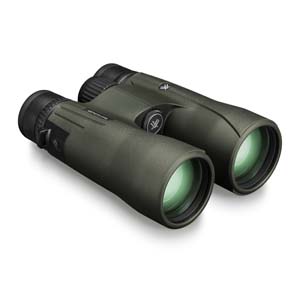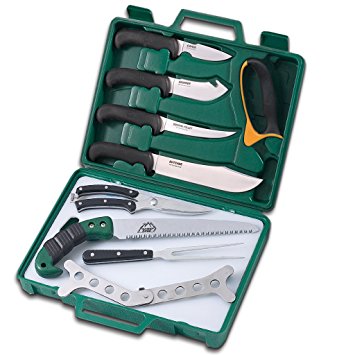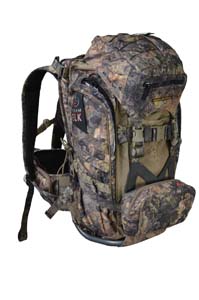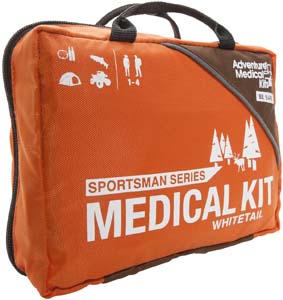Americans are addicted to toilet paper,” an immigrant from a Third World country once laughed at me. Having traveled a good portion of this planet to places where TP is an uncommon luxury, I could laugh with her at that observation. But I don’t agree with it, as folks usually don’t leave their addictions behind when they go big game hunting and it’s a pretty good bet we’ve all forgotten the TP once or twice.
I wouldn’t presume to make a comprehensive list of must-haves for your first or next big game hunt – even a book would fail to cover all the bases, as after listing “Hat” there are about 7.5 billion possible items we might add, depending on the local environment and the specific pursuit itself. Instead, here are a few thoughts, memory prompts and suggestions that may aid in selecting essentials for your big game hunt.
Feets, don’t fail me
Regardless of climate and transportation considerations, it’s a pretty good bet that at some point our big game hunt will include a bit of walking. How much so depends on whether we are plotting a black bear from a tree stand, hoofing it over ridges in pursuit of elk or skulking through desert washes after Coues deer. A good way to end a big game hunt or turn it into a cheerless test of discomfort endurance is with improper footwear.
The boots I wear in Arizona for December elk are not the ones I wear for January javelina because the environments the animals inhabit only a few miles and a few weeks apart are very different (OK, javelina aren’t big, but are classed as “big game” animals under hunt regulations nonetheless). One hunt requires footwear that’s tall, waterproof and insulated and the other, low, lightweight and ventilated. My stepdad owned one pair of plain leather Irish Setter boots for all hunting he did in Vermont; here in the economic good times of the future, we are more fortunate. Today’s Irish Setters include their modern Vaprtek 400 Gram hunting boot with ScentBan , which weighs about half as much as their old leather jobs, thanks to its composite sole material; the maker says it feels about like wearing an athletic shoe. If your hunt is colder climates, check out their Elk Tracker 12-inch high leather boot with 1000 grams of insulation and also with ScentBan.
Wick it
“Dress for success” applies to hunting as much as it does to business. That doesn’t necessarily mean just selecting matching camouflage clothing for your hunt locale; though generations of successful hunters before us found camo unnecessary, they did find that comfort can make a hunt. Today we’ve got synthetic materials that can outperform wool and cotton in turning rain and holding heat and wicking sweat; the many environment-specific camo patterns available to us is just a bonus.
Rain or snow may or may not be a consideration on your specific hunt. Something I seem to relearn every few years is the importance of waterproofing both myself and my gear. Most outerwear that’s 100 percent waterproof over a full day of downpour is not especially breathable, so it traps body heat and sweat. Sweat-wicking base layer underwear is helpful in moving sweat off the body, but then that sweat has to somehow evaporate to the outside air. A near-hypothermic experience in Alaska has since taught me that nothing beats Gore-Tex outerwear for snow-and-cold environments; because Gore-Tex is also breathable, it allows insulating base layers like Coldpruf to wick sweat and evaporate it to the outside. Coldpruf rates their insulating base layers from merely “cold” to “extreme cold,” and sizes run from XS/Youth to XL.
Get in - Get out
Handheld GPS units are marvelous tools for navigating, especially for those with limited map & compass skills and the many who lack that enviable homing pigeon sense of direction. They’re especially useful for marking and returning to the spot of downed game when we have to make multiple trips to pack out meat. Basic units start at about $100; the more you pay the better and more refined the display and the features – and the more detailed the operations you must learn.
The downside to GPS is that anything electronic is prone to sudden failure. Also, GPS must acquire a minimum of three satellites to accurately triangulate position; canyons, mountains and other rugged terrain routinely puts GPS out of commission for hunters on foot. A map & compass – and the skill to use them – are still essential to many hunts.
Topographic maps are the only way to go, of course, unless you have a penchant for guesswork and surprises and US Geological Survey maps are the trusted standard. Making them even better, mytopo.com offers completely custom USGS maps of the specific area of your hunt. You customize the scale of the map area and the physical size of the map and you can even have mytopo print it on waterproof paper. One of my 36”x 36” mytopo maps shows inholding properties in the local National Forest and includes the names of the property owners. To preclude arguments over who owns this fine map, mytopo professionally printed my name in the map margin. Maps this large on waterproof paper cost $50; smaller maps go for less.
 Got glass?
Got glass?Growing up hunting in the thick, often jungle-ish woods of Florida, I had little use for binoculars. Here in the American West where the horizon is typically miles away, binoculars and sometimes a spotting scope are essential for most hunting.
Like riflescopes, it’s a good idea to pay as much as we can afford for good binoculars. Inexpensive pocket-size binos are OK for packing light and covering ground when scouting, but we need quality, larger glass for a lot of big game hunting. “Larger” is perhaps a minimum of 8x42, though your hunt and terrain may dictate more or less.
Vortex Optics have made a big splash in the market the last few years and for good reason. Their glass is clear and with their highest priced bino/rangefinder combo topping out at about $1,600, you won’t break the bank either. And with models ranging from as low as $189, you are sure to find a pair that is just right for you.
With HD (High Density) extra-low dispersion glass, one look is all you’ll need to appreciate why the Viper HD is an award-winning bino. Add XR fully multi-coated lenses and you have a bino that delivers bright, crisp details with impressive resolution and color fidelity. Rugged, compact and lightweight—the Viper is one of the lightest full-size binos available. Viper HD binoculars pack in all the features you need for a successful hunt.
Night sight
If you’ve ever trailed a wounded game animal into the dark hours and field-dressed it by light of a flashlight, you know that hands-free illumination is essential. There are plenty of choices in headlamps, but all of them are trade-offs between lumens (brightness) and battery duration – basically, the brighter the light, the shorter the battery life. The Cyclops Quad Mode headlamp allows you to select only the level of light output needed; three AAA batteries will shine a brilliant 120 lumens for 6 hours, while 72 lumens will last about 10 hours. If you want more lumens, PETZL’s Actik Core headlamp pumps out 350 of ‘em from either three AAAs or from an included USB rechargeable battery pack.
 Elk reduction
Elk reductionWhile we’re working in clichés, “The proper tool for the proper job” applies to field dressing big game animals perhaps more so than to other pursuits. The Outdoor Edge Game Processor kit is not much larger than a plastic pistol box, but it carries essential tools for reducing a big critter to pack-out size. The kit includes four different knives, a rib spreader, a bone saw, long-nosed snips and, of course, a sharpener.
 Packing out big game meat on foot usually means making multiple trips – how many depends on how much meat the available backs in your party can pack. A pack frame that’s uncomfortable can turn this hunt aspect into torture. Eberlestock says their aluminum frame Team Elk Pack with a stowaway rifle scabbard can handle an elk quarter comfortably if you can. At 2600 cubic inches the Team Elk Pack is larger than a day pack and big enough for a minimalist to stay out for several days and weighing in at about six pounds empty, you can carry that much more meat.
Packing out big game meat on foot usually means making multiple trips – how many depends on how much meat the available backs in your party can pack. A pack frame that’s uncomfortable can turn this hunt aspect into torture. Eberlestock says their aluminum frame Team Elk Pack with a stowaway rifle scabbard can handle an elk quarter comfortably if you can. At 2600 cubic inches the Team Elk Pack is larger than a day pack and big enough for a minimalist to stay out for several days and weighing in at about six pounds empty, you can carry that much more meat.Energy foods
Active hunting is one time when we don’t really have to worry about calorie counting; especially when spending the day scouting and stalking over miles of rough terrain, we can easily burn twice the calories as we would as flatland office workers commuting to work in a car. That said, many hunters discover that a high-calorie meal before and after a hunting day is maybe less important than high-calorie snacks that are easy to pack along. There are a lot of high calorie (or “energy dense,” if you prefer) packaged snacks out there, from simple candy to designer energy bars and it’s the wise hunter who buys samples and tries them at home before taking them on a hunt. It can be a bit disappointing to be two hours’ hike from camp, get that hypoglycemic shaky-hungry feeling and discover your cool new snack bars apparently include sawdust and bird droppings not listed in the ingredients.
Trail mix is popular because it includes a lot of what we need out there, natural sugars in the dried fruit and proteins and a little salt in the nuts. The candy-coated chocolates in trail mix may or may not contain high fructose corn syrup which, apparently, the body deposits as fat, rather than burns as fuel, so is not useful for immediate energy. Simple fruits that can survive hiking, such as apples and oranges, are good choices, too, of course.
 Communicate
CommunicateSmall handheld radios are a boon to hunting parties, allowing coordination of efforts and emergency communication. Many are sold in pairs and outer package printing frequently claims working ranges of 30 or more miles. However, those claims are only achievable under optimum conditions of clear weather and dinner-plate-flat terrain or glass-calm waters. The reality is that the FCC-compliant low output of these small handhelds, combined with rugged terrain, thick, wet forest or bad weather can limit radio reception to a fraction of a mile. Still, these little radios have big benefits that outweigh the tiny amount of space they require. Let other features, such as waterproofing or compactness, rather than distance claims, decide your choice.
Fire starting
I’ll admit to still having a 12-year-old Inner Boy Scout who ranks outdoorsmanship with the ability to start a fire with a single match – or none. As an adult nod toward efficiency and success, I sometimes cheat by using a fire starter of some kind. During my flying years I carried in my survival vest a plastic sandwich bag of a half-dozen Vaseline-saturated cotton balls for fire starters. If you prefer something that burns longer in anticipation of damp kindling, try a hexamine or trioxane camp stove solid fuel tablet. Kept dry, they have a near-infinite shelf life. A votive candle lit under a pile of stacked kindling works if there’s no wind. If you want to go more primitive with matchless fire starting, know that it takes practice to use those magnesium/flint & steel starters.
Quick fixes
Leatherman and Gerber are probably the best-known among multi-tools. I don’t know anyone who has ever made use of the little saw blade (is it really a fish scaler?), but multi-tools are great for pulling cactus thorns and making light equipment repairs. The cheap ones are about useless, so spend some coin, $45 and more, if you want to avoid disappointment.
We often joke about duct tape, but it got three men in a broken spaceship back to earth and it has endless uses around camp. A roll of duct tape can survive for years behind a truck seat, so there’s no reason to leave it at home.
 Emergencies
EmergenciesFirst aid kits are a subject unto themselves. Generally, a minimum is one that has items for disinfecting and covering minor wounds and for keeping larger wounds closed (in a pinch, the aforementioned duct tape can hold closed a really nasty gash ‘til you can get to an ER). Anything much more beyond that becomes too specific to your type of hunt to cover in a paragraph or two here. Adventure Medical Kits first aid kits come in a wide variety of outdoors-specific choices intelligently rated for the number of expected persons or days in the field. Their Whitetail and Waterproofed Steelhead kits include an excellent selection of first aid items that are both minimal and useful.
I carry a palm-size soft case first aid kit when mountain biking, fishing and making other outdoors solo day trips and it takes up almost no space in a fanny pack when scouting or stalking. Snake bite kits? Professional medical opinion today says that cutting open venomous snake bites to suck out the venom doesn’t work. Honestly, I wasn’t going to do that for you anyway.
Over here!
A 20-year military aviation career that included desert, jungle and sea survival schools and a civilian stint as a scuba instructor has given me a bit of a what-if focus on possible emergencies. Here we have to make tradeoffs between the likelihood of what bad thing might happen and what space constraints allow us to bring along to deal with that possibility. In this regard, we’re actually gambling a bit, but hunting, like other fun stuff in life, has inherent risk that we accept. We don’t expect to break a leg, though it could happen and yet few hunt lists include “Stokes litter”; they should, however include some means of communicating distress in a hunt gone seriously sour.
Communication methods, in order of their range, are aural, visual or electronic. When was the last time you heard of three gunshots actually bringing help a-running? Me, either. However, the sound of a simple plastic whistle can carry nearly a mile on a calm day in open terrain or water.
Visual communication can be passive or active. The orange and silver emergency blanket is passive (or active if you wave it), but it can communicate details to aerial searchers when you fold it in the symbol patterns in the included instructions. Signal flares are excellent for attracting the attention of aerial searchers, but can be difficult to be seen and localized by searchers on the ground.
Electronic comms are preferred – when they work. Cell phones have 911 and GPS locator capabilities, but we all know that signal coverage is not guaranteed – your specific hunt location and terrain will determine that. List those small handheld radios here, too, but we often turn them off while hunting to conserve batteries or prevent spooking game, so it’s a good idea to prearrange times when everyone will turn theirs on just in case someone is in distress.
& etc.
Be sure to add “Battteries” to the list. It pays to sit a few minutes and itemize every individual battery powered device you’ll take on your hunt - flashlights, rifle scopes, rangefinders, radios, etc. – and bring along spare batteries for each. And don’t forget that flashlights often pack along their own spare bulbs on the inside cover of the battery compartment.
A roll of surveying tape is handy for marking the trail-less path back to downed game or a promising spot if you don’t rely on a GPS and even if you do, the brightly colored tape can help those behind you find your path. Some hunters also use small reflective markers for night time use.
One item often forgotten is, “Entertainment.” Hunts that require several days and nights in the field are not just eat, hunt, sleep. Elk hunting with a friend a few years ago, a simple deck of cards offered welcome relief for cabin fever on snowed-in nights in a tiny camp trailer.
Regardless of what you add to your Hunt Essentials List, it makes good sense to try out anything new at home or on short camping trips or day hikes before packing them along on an important hunt.
Oh - and don’t forget the TP.

